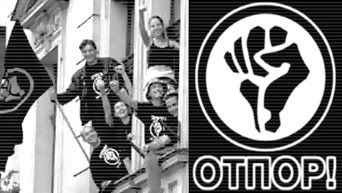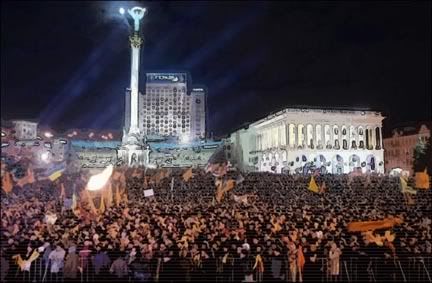Adam Larson
Caustic Logic / Guerillas Without Guns
November 2006
re-posted 2/17/07
As the second NATO bombing campaign against Serbia came and went in early-mid 1999, it was the young who led the way out of NATO’s fire and into the West’s frying pan. “Otpor!” is a Serbian word for “Resist” or “Resistance.” It was chosen as a name for a presumably sincere group of dissident students at the University of Belgrade in October 1998. [1] They were reportedly incensed at Milosevic’s repressive media laws, and immediately launched a graffiti campaign across downtown Belgrade, leaving images of their name and their clenched-fist symbol. An early Otpor early website reportedly explained “the fist itself is conceived as the symbol of individual initiative, that the time and energy of every single person should be invested to bring about change. This symbol of personal courage was born with the first public manifestation of RESISTANCE, a leaflet called "Bite the System." [2]
As NATO air strikes poured over their territory and people rallied around the government in early-mid 1999, Otpor’s public activities paused; people refused to rise up in apparent solidarity with the people bombing their country. But in the disastrous aftermath of the bombings, late 1999 and into 2000, the students resumed, taking bigger bites further beyond the campus. Otpor took root in the south and the rural areas; there were eventually more than eighty branches of the movement, with each branch representing a Serbian city. [3]
In Belgrade, an Otpor-led street campaign against Milosevic targeted the minds of the capital’s electorate. They drew on existing American mental technologies, seeking to brand their name and message into the brains of Serbia. Ivan Marovic, a leader of the Otpor movement explained “our idea was to use corporate branding in politics. The movement has to have a marketing department. We took Coca-Cola as our model.” [4] Marovic also described to a BBC Malaysia reporter the techniques used in their campaign, involving creativity, humor, and an uncommon application of strategic psychology:
“In the first phase, we used symbolic street actions. Small number of people would organize the action, which would symbolize the problems they were facing in their own towns. These actions were not something that were too dangerous, so people could easily join and by doing that they could show that they were not satisfied with the situation in the country. With these actions that had a dosage of humour and laugher we managed to break away fear which was the main problem facing [them] under Milosevic’s dictatorship.[5]
In early May the political front shaped up with the emergence of a unified Opposition coalition; eighteen political parties merged into the Democratic Opposition of Serbia (DOS). By this time, Otpor itself was ready to challenge the President directly; in the two years since the group’s inception, it had grown to at least 70,000 members, a force to be reckoned with. The police fought back, but no matter what the authorities did, the movement just got bigger. Thousands of young protesters were arrested. Perhaps hundreds were beaten and interrogated, but the movement’s leadership proved tough to ferret out; Otpor prided itself on the fact that the group had no single leader or hierarchical structure, which rendered ordinary suppression nearly impossible.
Radio Free Europe reported that “Otpor is a state of mind rather than an organization,” a contention backed up by Nis Deputy Mayor Toplica Djordjevic, a Milosevic foe, who told RFE/RL “how many people are in Otpor in Nis I cannot say. But how strong are they as an idea, as a movement -- that is easy to say. Otpor is everywhere. Otpor is an idea that young people embrace and struggle for with full force and full legitimacy.” [7]

The Otpor logo and its advertisement by activists in Belgrade, 2000. Ivan Marovic: “We took Coca-Cola as our model.”
On May 13 a Socialist Party ally of Milosevic, Bosko Perosevic, was gunned down in Novi Sad. The assassin was quickly arrested and accused of membership in Otpor and the SPO opposition party, based on literature found in his apartment. Otpor claimed the evidence was planted, and responded shrewdly that same day with a “surrender action,” handing their membership lists over to the authorities – and to the media. They were apparently banking on the PR move as a sign of innocence, but the government accelerated its repression and arrested many of the activists on the lists anyway, calling them “fascists” and “terrorists.” [8]
Once the youth movement went public, it was no longer a matter of ferreting them out – everybody knew who Otpor were and they were all so cute and brave. Opposition activist Slobodan Vuksanovic touted the movement’s appeal is Serbia as “young people who certainly are not trusted for their experience. They cannot be experienced. Rather, they are trusted because they are clean.” [9] Srdja Popovic, the 27 year-old self-described “ideological commissar” of Otpor, explained that their nonviolent methods had been designed “to show how superior, how advanced, how civilized” they were, and the approach worked quite well. [10] Ordinary citizens, realizing their own children were members, gradually came to accept the movement as the inevitable face of the future. Andrew Mueller interviewed “Otpor’s nominal figurehead,” 20-year-old Branko Ilic. Ilic described the group’s role in the success, describing himself and his comrades as “guerrillas without guns.” [11]
On July 17 Milosevic, having pushed through Parliament a constitutional amendment that would allow him two more terms as president, announced early elections scheduled for September 24, perhaps afraid his popularity would fall after that. [13] As the political opposition moved towards greater unity, Otpor focused on securing the upcoming elections for the opposition. Their prime achievement to this end was their 2000 Gotov Je (“He’s Finished”) pre-election campaign. Over two million stickers announcing this belief were placed around Belgrade and elsewhere to mobilize as many disaffected voters to the polls as possible to vote their conscience – this time they weren’t going to let it be stolen.
So the fight moved to a different level; the government issued a statement blaming all unrest on the cross-pressure from NATO-controlled information warfare and the activities of “an internal fifth column.” [14] Milosevic ran a series of ads targeting Otpor as “NATO foot soldiers” and tools of foreign powers; the spots cleverly had the trademark Otpor fist clenched around a wad of American dollars. [15] The public at the time dismissed the campaign as a cynical lie from a desperate ruler, solidifying in their minds that indeed “Gotov Je.”
Sources:
[1],[6] Pozun, Brian. "Planning for an Uncertain Future." Central EuropeReview. February 26 2001. http://www.ce-review.org/01/8/pozun8.html
[2] "Bulgarian paper says CIA is tutoring Serbian group Otpor." From the Bulgarian newspaper The Monitor. Translated by Blagovesta Doncheva. (Posted 9-8-00) http://emperors-clothes.com/news/cialectures.htm
[3] Sell, Louis. Milosevic and the Destruction of Yugoslavia. Page 339.
[4] Traynor, Ian. “Young democracy guerrillas join forces: From Belgrade to Baku, activists gather to swap notes on how to topple dictators.” The Guardian. June 6 2005. http://www.guardian.co.uk/international/story/0,,1499871,00.html
[5] Htet, U Min. "Serbia: Demise of a Dictator." BBC News. September 16 2005. http://www.bbc.co.uk/burmese/learning/story/2005/09/050912_transition_prog12.shtml
[7] Naegele, Jolyon. “Yugoslavia: Otpor Launches Get Out the Vote Campaign.” Radio Free Europe/Radio Liberty. July 18 2000. http://www.rferl.org/features/2000/07/f.ru.000719154500.asp
[8] Human Rights Watch. http://www.hrw.org/backgrounder/eca/serbia0601.htm
[9]
[10]


No comments:
Post a Comment